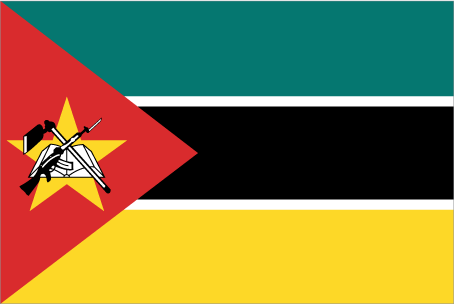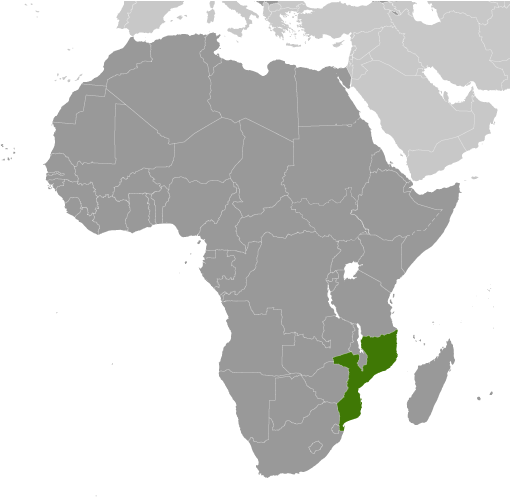
|
|
Advertisements:
EconomyEconomy - overview
At independence in 1975, Mozambique was one of the world's poorest countries. Socialist mismanagement and a brutal civil war from 1977-92 exacerbated the situation. In 1987, the government embarked on a series of macroeconomic reforms designed to stabilize the economy. These steps, combined with donor assistance and with political stability since the multi-party elections in 1994, have led to dramatic improvements in the country's growth rate. Fiscal reforms, including the introduction of a value-added tax and reform of the customs service, have improved the government's revenue collection abilities. Inspite of these gains, Mozambique remains dependent upon foreign assistance for more than half of its annual budget, and in 2008 54% of the population remained below the poverty line. Subsistence agriculture continues to employ the vast majority of the country's work force and smallholder agricultural productivity and productivity growth is weak. A substantial trade imbalance persists although the opening of the Mozal aluminum smelter, the country's largest foreign investment project to date, has increased export earnings. At the end of 2007, and after years of negotiations, the government took over Portugal's majority share of the Cahora Bassa Hydroelectricity Company (HCB), a dam that was not transferred to Mozambique at independence because of the ensuing civil war and unpaid debts. More electrical power capacity is needed for additional investment projects in titanium extraction and processing and garment manufacturing that could further close the import/export gap. Mozambique's once substantial foreign debt has been reduced through forgiveness and rescheduling under the IMF's Heavily Indebted Poor Countries (HIPC) and Enhanced HIPC initiatives, and is now at a manageable level. In July 2007 the Millennium Challenge Corporation (MCC) signed a compact with Mozambique; the compact entered into force in September 2008 and will continue for five years. Compact projects will focus on improving sanitation, roads, agriculture, and the business regulation environment in an effort to spur economic growth in the four northern provinces of the country. Mozambique grew at an average annual rate of 9% in the decade up to 2007, one of Africa's strongest performances. However, heavy reliance on aluminum, which accounts for about one-third of exports, subjects the economy to volatile international prices. The sharp decline in aluminum prices during the global economic crisis lowered GDP growth by several percentage points. Despite 6.8% GDP growth in 2010, the increasing cost of living prompted citizens to riot in September 2010, after fuel, water, electricity, and bread price increases were announced. In an attempt to contain the cost of living, the government implemented subsidies, decreased taxes and tariffs, and instituted other fiscal measures. Real growth of 7.2% was achieved in 2011. Gdp (purchasing power parity) World Ranking: 121
$24.19 billion (2011 est.)
$22.58 billion (2010 est.) $21.15 billion (2009 est.) Note Data are in 2011 US dollars Gdp (official exchange rate)
$12.83 billion (2011 est.)
Gdp - real growth rate World Ranking: 28
7.1% (2011 est.)
6.8% (2010 est.) 6.3% (2009 est.) Gdp - per capita (ppp) World Ranking: 211
$1,100 (2011 est.)
$1,000 (2010 est.) $1,000 (2009 est.) Note Data are in 2011 US dollars Gdp - composition by sector
Agriculture 31.5%
Industry 23.8% Services 44.7% (2011 est.) Labor force World Ranking: 50
9.973 million (2011 est.)
Labor force - by occupation
Agriculture 81%
Industry 6% Services 13% (1997 est.) Unemployment rate World Ranking: 165
21% (1997 est.)
Population below poverty line
54% (2008 est.)
Household income or consumption by percentage share
Lowest 10% 1.9%
Highest 10% 36.7% (2008) Distribution of family income - gini index World Ranking: 38
45.6 (2008)
47.3 (2002) Investment (gross fixed) World Ranking: 32
26.9% of GDP (2011 est.)
Budget
Revenues $3.724 billion
Expenditures $4.176 billion (2011 est.) Taxes and other revenues World Ranking: 97
29% of GDP (2011 est.)
Budget surplus (+) or deficit (-) World Ranking: 114
-3.5% of GDP (2011 est.)
Public debt World Ranking: 99
34.9% of GDP (2011 est.)
35% of GDP (2010 est.) Inflation rate (consumer prices) World Ranking: 193
10.4% (2011 est.)
13% (2010 est.) Central bank discount rate World Ranking: 31
3.25% (31 December 2010 est.)
9.95% (31 December 2009 est.) Commercial bank prime lending rate World Ranking: 33
19.1% (31 December 2011 est.)
16.263% (31 December 2010 est.) Stock of narrow money World Ranking: 110
$3.575 billion (31 December 2011 est.) $2.736 billion (31 December 2010 est.) Stock of broad money World Ranking: 127
$5.268 billion (31 December 2011 est.) $4.033 billion (31 December 2010 est.) Stock of domestic credit World Ranking: 113
$5.34 billion (31 December 2011 est.) $2.92 billion (31 December 2010 est.) Market value of publicly traded shares
$NA
Agriculture - products
Cotton, cashew nuts, sugarcane, tea, cassava (tapioca), corn, coconuts, sisal, citrus and tropical fruits, potatoes, sunflowers; beef, poultry Industries
Aluminum, petroleum products, chemicals (fertilizer, soap, paints), textiles, cement, glass, asbestos, tobacco, food, beverages Industrial production growth rate World Ranking: 29
8% (2010 est.)
Electricity - production World Ranking: 79
14.98 billion kWh (2008 est.)
Electricity - consumption World Ranking: 88
10.18 billion kWh (2008 est.)
Electricity - exports
11.21 billion kWh (2008 est.)
Electricity - imports
3.436 billion kWh (2008 est.)
Oil - production World Ranking: 204
0 bbl/day (2010 est.)
Oil - consumption World Ranking: 135
17,000 bbl/day (2010 est.)
Oil - exports World Ranking: 181
0 bbl/day (2009 est.)
Oil - imports World Ranking: 131
14,540 bbl/day (2009 est.)
Oil - proved reserves World Ranking: 168
0 bbl (1 January 2011 est.)
Natural gas - production World Ranking: 52
3.6 billion cu m (2009 est.)
Natural gas - consumption World Ranking: 104
100 million cu m (2009 est.)
Natural gas - exports World Ranking: 31
3.5 billion cu m (2009 est.)
Natural gas - imports World Ranking: 97
0 cu m (2009 est.)
Natural gas - proved reserves World Ranking: 52
127.4 billion cu m (1 January 2011 est.) Current account balance World Ranking: 132
-$1.422 billion (2011 est.)
-$1.113 billion (2010 est.) Exports World Ranking: 128
$2.649 billion (2011 est.)
$2.333 billion (2010 est.) Exports - commodities
Aluminum, prawns, cashews, cotton, sugar, citrus, timber; bulk electricity Exports - partners
Belgium 17.8%, South Africa 17.4%, Italy 13.9%, Spain 10%, China 7.7% (2011) Imports World Ranking: 134
$4.029 billion (2011 est.)
$3.512 billion (2010 est.) Imports - commodities
Machinery and equipment, vehicles, fuel, chemicals, metal products, foodstuffs, textiles Imports - partners
South Africa 22.1%, China 12.4%, India 9.1%, US 8%, Australia 7.4%, Portugal 5.4% (2011) Reserves of foreign exchange and gold World Ranking: 113
$2.469 billion (31 December 2011 est.) $2.159 billion (31 December 2010 est.) Debt - external World Ranking: 124
$4.32 billion (31 December 2011 est.) $3.804 billion (31 December 2010 est.) Exchange rates
Meticais (MZM) per US dollar -
29.068 (2011 est.) 33.96 (2010 est.) 26.28 (2009) 24.125 (2008) 26.264 (2007) Fiscal year
Calendar year
Comments
Add a new comment: |
Advertisement
Members area
Mozambique (Maputo):
 
GPS points from Mozambique (Maputo)
|
||||||||

 Almost five centuries as a Portuguese colony came to a close with independence in 1975. Large-scale emigration, economic dependence on South Africa, a severe drought, and a prolonged civil war hindered the country's development until the mid 1990s. The ruling Front for the Liberation of Mozambique (Frelimo) party formally abandoned Marxism in 1989, and a new constitution the following year provided for multiparty elections and a free market economy. A UN-negotiated peace agreement between Frelimo and rebel Mozambique National Resistance (Renamo) forces ended the fighting in 1992. In December 2004, Mozambique underwent a delicate transition as Joaquim CHISSANO stepped down after 18 years in office. His elected successor, Armando Emilio GUEBUZA, promised to continue the sound economic policies that have encouraged foreign investment. President GUEBUZA was reelected to a second term in October 2009. However, the elections were flawed by voter fraud, questionable disqualification of candidates, and Frelimo use of government resources during the campaign. As a result, Freedom House removed Mozambique from its list of electoral democracies.
Almost five centuries as a Portuguese colony came to a close with independence in 1975. Large-scale emigration, economic dependence on South Africa, a severe drought, and a prolonged civil war hindered the country's development until the mid 1990s. The ruling Front for the Liberation of Mozambique (Frelimo) party formally abandoned Marxism in 1989, and a new constitution the following year provided for multiparty elections and a free market economy. A UN-negotiated peace agreement between Frelimo and rebel Mozambique National Resistance (Renamo) forces ended the fighting in 1992. In December 2004, Mozambique underwent a delicate transition as Joaquim CHISSANO stepped down after 18 years in office. His elected successor, Armando Emilio GUEBUZA, promised to continue the sound economic policies that have encouraged foreign investment. President GUEBUZA was reelected to a second term in October 2009. However, the elections were flawed by voter fraud, questionable disqualification of candidates, and Frelimo use of government resources during the campaign. As a result, Freedom House removed Mozambique from its list of electoral democracies.